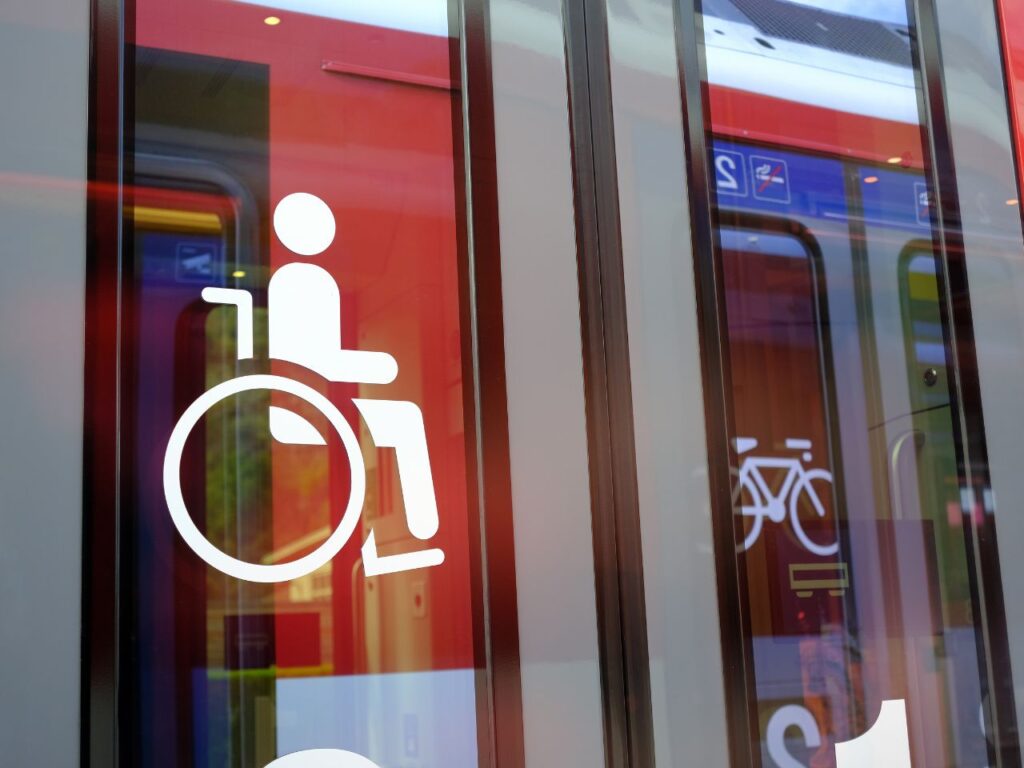Updated on August 20, 2024

Accessible rail travel in Australia provides people with limited mobility the opportunity to explore the country’s beautiful landscape with confidence and independence.
Importance of Accessibility and Inclusivity on the Railway
According to the International Institute for Sustainable Developments (IISD), “Railways currently carry 8% of the world’s passengers and 7% of global goods, and represent only 2% of global energy demand for transport.”
Transportation by rail is reliable, cost-effective, more energy-efficient, and on-time than other modes of transportation; especially for long distances and high passenger volumes.
Railway accessibility refers to the ease with which people can use the railway system, particularly those with disabilities or mobility issues. Ensuring that railways are accessible and approachable allows people with disabilities to travel independently and feel welcomed in society. Accessibility makes public transport more convenient for everyone, and it can improve public health by promoting active modes of transport such as walking and strolling.
Australian legislation, such as the Disability Discrimination Act 1992, mandates accessibility standards for public transportation, including railways, to eliminate discrimination and promote inclusivity.
How do Wheelchairs Get on Trains?
Rail stations continue to upgrade their accessibility features to meet accessibility standards for customers with limited mobility. These accessibility amenities include ramps and bridge plates to get onboard the train, elevators, tactile indicators, and wide-accessible pathways. The accessibility features on trains include wheelchair-designated spaces, priority seating, and accessible bathrooms equipped with grab bars and emergency call buttons.
What is Priority Seating on a Train?
Priority seats are designated in public transport vehicles by operators to allow the disabled, elderly, pregnant women and the injured to take public transport with an equal degree of access and comfort as other people.
They can be found on various mass transit public transportation such as trains, buses, minibuses, and trams. Priority seats are usually covered in orange fabric and will be closest to aisles and doors. On some trains, trams or buses, the seats may not be orange but will have a priority seating sticker above the designated seats.
Priority seating should be made available upon request for use by any passengers with additional needs or extra support while travelling. You can be fined by an Authorised Officer for not giving up your priority seat to a request from a passenger with additional needs.
Are there Toilets on Trains?
Many trains provide an onboard unisex accessible toilet which varies between the New Generation Rollingstock (NGR) trains and older trains.
Older Trains
Accessible toilets can be found at the end of the first, third, fourth or sixth car in a typical six-car coupled older train. The locations depend on how the train is coupled. Signages are available on train car doors to indicate the location of the toilet within the train. Another signage is also placed inside the car to indicate the direction of the toilet within the train.
In a single three-car older train the one accessible toilet is located in either the first or last car, depending on the travelling direction. You can make enquiries with station staff and train crew to know whether there is a toilet onboard and if so, the car it is located in.
Older train toilet modules feature a toilet, baby change table, mirror, hand wash basin, soap dispenser, hand dryer, and two emergency help points.
NGR Trains
All NGR six-car trains have one onboard unisex accessible toilet located in either the third or fourth car, depending on the direction of travel. A signage on the car door or inside the cars indicates the direction of the toilet on the train.
Station staff and train crew providing boarding assistance for NGR services can provide information on the car with accessible toilets. Each NGR toilet module currently features a toilet, baby change table, mirror, handwash basin, soap dispenser, hand dryer, and two emergency help points
Passenger Services and Support
Rail operators provide a range of assistance services to passengers with limited mobility. These services range from booking assistance to boarding support, and in-transit assistance. The rail operators’ station and train staff undergo professional training to provide adequate assistance to passengers with disabilities. They ensure a supportive and accommodating travel experience for everyone. Accessible information is available on various rail operator channels like websites, apps, and customer service hotlines. They provide real-time updates and travel assistance.
Plan Your Journey
Planning ahead and being familiar with accessible features and services available at your departure and destination stations is essential before you embark on your journey by rail. You can contact the rail operator in advance for any assistance or accommodations you may require for your trip. Lastly, remember to pack essentials like mobility aids, medications, and important documents to ensure you have everything you need for a comfortable and stress-free travel experience.
Looking for reliable and trustworthy care services?
At Centre Disability Support, we offer tailored support services for individuals with disabilities throughout Australia. We offer housing options in Logan, Ipswich and Brisbane areas, where we provide independent supported living or assist individuals in finding suitable options for individualised living.
Additionally, we provide day-to-day support for individuals with mental health issues, complex behaviour and other types of disabilities. We also have support coordinators available to assist with planning, navigating NDIS plans, and offering casework support.
Whether you’re seeking support for yourself, or a loved one, or simply wish to learn more about our services, we’re here to help.
ALSO READ
Accessible Accommodation: What You Need to Know
10 Wheelchair Accessible Beaches In Australia
10 Accessible Destinations in Australia



